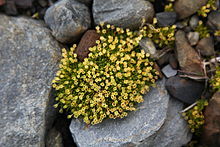Colobanthus quitensis
| Colobanthus quitensis | |
|---|---|

| |
| Antarctic pearlwort at St. Andrews Bay, South Georgia | |
| Scientific classification | |
| Kingdom: | Plantae |
| Clade: | Tracheophytes |
| Clade: | Angiosperms |
| Clade: | Eudicots |
| Order: | Caryophyllales |
| Family: | Caryophyllaceae |
| Genus: | Colobanthus |
| Species: | C. quitensis
|
| Binomial name | |
| Colobanthus quitensis | |
| Synonyms[1] | |
| |
Colobanthus quitensis, the Antarctic pearlwort, is one of two native flowering plants found in the Antarctic region.[2] It has yellow flowers and grows about 5 cm (two inches) tall, with a cushion-like growth habit that gives it a moss-like appearance.
Distribution
[edit]It is found on the west coast of the Antarctic Peninsula, on South Georgia, South Shetland and the Falklands; also in the Andes, becoming increasingly rare northwards, but reaching Bolivia, Peru and Ecuador, with a further isolated population in Mexico.[3]
Climate change
[edit]Within Antarctica, due to climate change, more seeds are germinating, creating a large number of seedlings and plants. Reports indicate a fivefold increase in these plants, which have extended their ranges southward and cover more extensive areas, wherever found. Research found that the Antarctic pearlwort spread nearly ten times faster during the period 2009 through 2018 compared to between 1960 and 2009.[4] Deschampsia antarctica (Antarctic hairgrass) is the only other native flowering plant in the region.[5]
References
[edit]- ^ a b "Colobanthus quitensis". Plants of the World Online. Royal Botanic Gardens, Kew. Retrieved 27 January 2020.
- ^ Kozeretska, Iryna (2005), THE HERBARIUM OF ANTARCTIC VASCULAR PLANTS, National Taras Shevchenko University of Kyiv, retrieved 9 February 2015
- ^ Colobanthus quitensis at botany.cz
- ^ "Flourishing plants show warming Antarctica undergoing 'major change'". the Guardian. 2022-02-14. Retrieved 2022-02-15.
- ^ Rudolph, E. D. (Apr 1965), "Antarctic Lichens and Vascular Plants: Their Significance", BioScience, 15 (4), American Institute of Biological Sciences: 285–287, doi:10.2307/1293425, JSTOR 1293425
External links
[edit] Media related to Colobanthus quitensis at Wikimedia Commons
Media related to Colobanthus quitensis at Wikimedia Commons Data related to Colobanthus quitensis at Wikispecies
Data related to Colobanthus quitensis at Wikispecies- British Antarctic Survey - Plants
- Pearlwort & Hairgrass picture
Text is available under the CC BY-SA 4.0 license; additional terms may apply.
Images, videos and audio are available under their respective licenses.
